I got fairly excited when I discovered Magnum Research had developed a new version of the Desert Eagle, the Desert Eagle 429 Mark XIX, chambered in Magnum Research’s new .429 DE cartridge.
Based on Magnum Research’s famous 50 AE cartridge, the .429 DE round was touted as having a 25-percent velocity increase over a .44 Rem Mag (when comparing 240-grain bullets launched from a six-inch barrel) and a 45-percent boost in energy. The company rated the velocity of new .429 DE cartridge at 1,600 feet-per-second (fps) with a 240- grain bullet and an impressive 1,750 fps with 210-grain bullets.
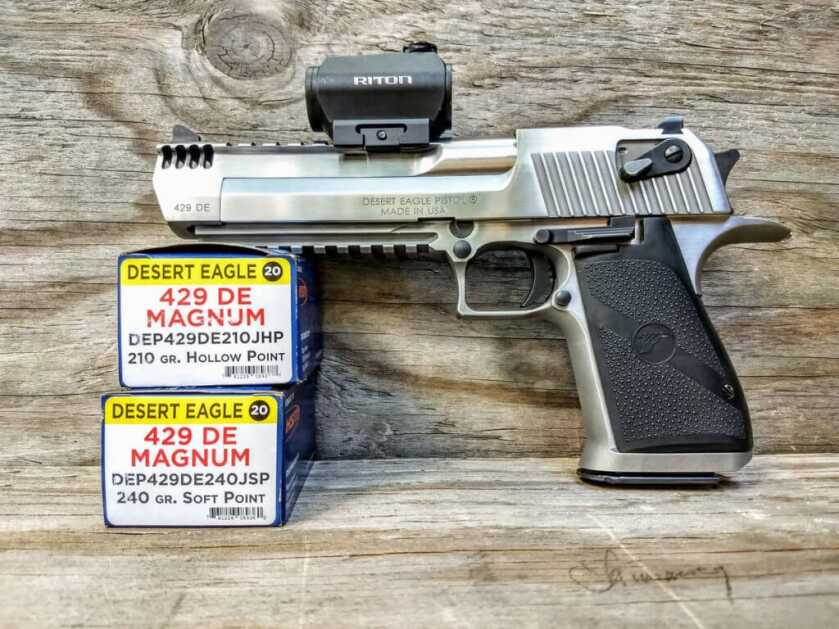
The Desert Eagle 429 Mark XIX pistol specs revealed a stainless-steel slide, a stainless-steel frame with Picatinny bottom rail, and a six-inch stainless-steel barrel with integral muzzle brake and black appointments.
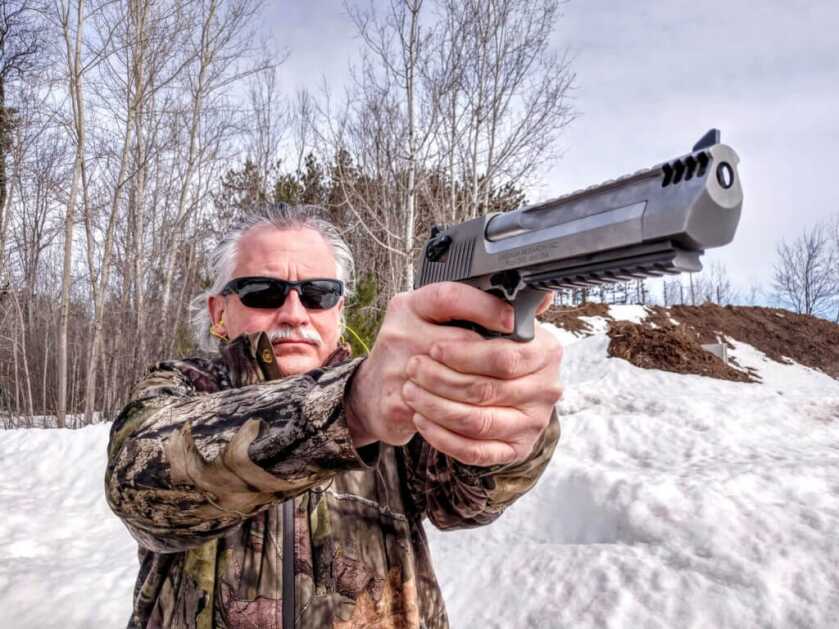
To me, it sounded like Magnum Research had developed a great semi-automatic handgun with a new round for hunting bear, deer, and hogs. The pistol/round combination suggested the potential to reach out considerably further and more effectively than other semi-auto pistols I’ve used for hunting.
So, I immediately requested and received a Desert Eagle 429, along with several boxes of the new .429 DE ammunition. What I discovered was that while the Desert Eagle 429 represents a fine idea, in practice the pistol itself has reliability and other functional problems that stop me from recommending it as a viable handgun.
With all that stainless steel, the Desert Eagle 429 is no lightweight, not at 4 pounds, 3 ounces—unloaded! It also features the Desert Eagle gas-operated, rotating bolt, a single-action trigger, combat-style sights, and a magazine capacity of seven rounds.
Given that weight, offhand shooting is tough, though not impossible. I started off by shooting offhand at ten yards and was able to punch a 1.5-inch group with my first two magazines, minus a couple of fliers. The first shots were always at or near bullseye, but weight and recoil caused me to move off target with follow up shots.
The real accuracy testing, I knew, would be from a rest; I moved to the 20- and 25-yard lanes of my outdoor shooting range to see what I could achieve and built up solid shooting rests.
And that’s when the problems started.
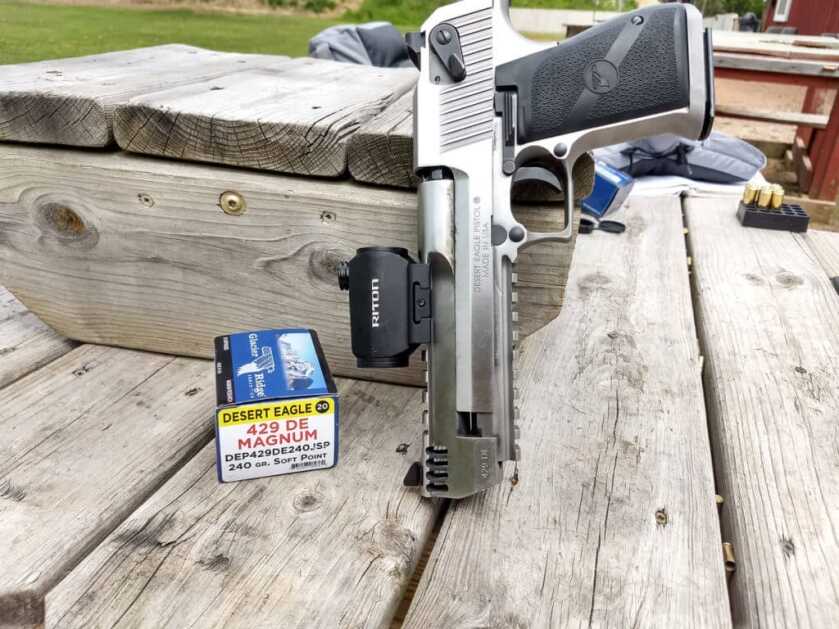
As I was shooting from a rest, the DE 429 began having problems going back into battery. I’d fire a shot and the pistol would eject the spent brass and chamber another round. However, the slide would stop a half-inch short of returning the pistol into battery.
Well, the recoil on the pistol is substantial and I assumed I wasn’t holding the grip tight enough. So, I tightened up.
Yet, the slide kept holding up.
I only had 25 rounds through the DE 429, so I didn’t think it needed cleaning. Yet, just to be sure, I disassembled the DE 429, cleaned off the slide area in particular and made sure the slide and any other moving parts had plenty of lubrication.
It didn’t help. Sometimes I could get off four to five shots without a holdup, sometimes every other shot required me to pop the slide forward and into battery.

The pistol’s gas-operated, rotating bolt does a good job of extracting the spent brass. Unfortunately, the bolt frequently kicks that brass back into the shooter’s face. The brass hit my prescription glasses hard enough to permanently scratch the right lens. I switched over to my prescription shooting/sunglasses. A spent brass casing scratched the right lens on these glasses, too, as in permanently.
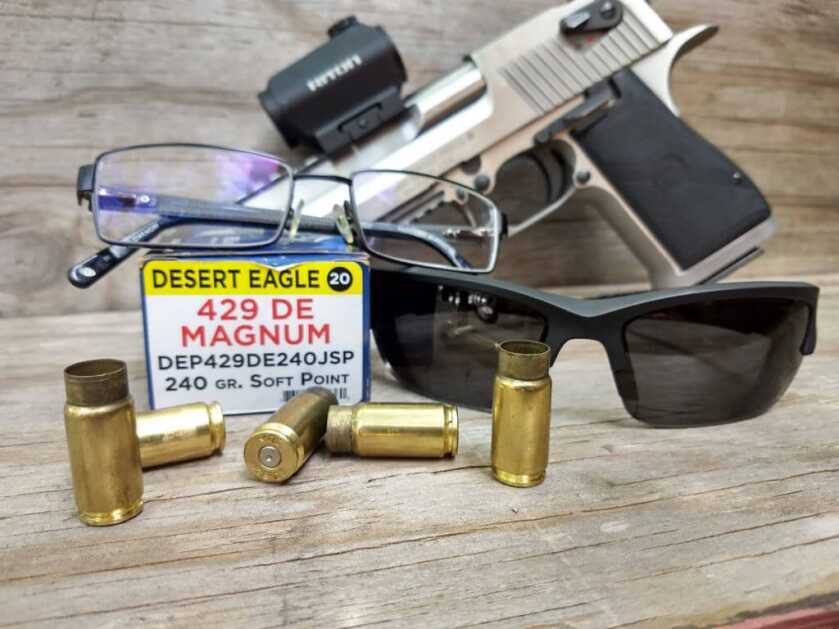
Accuracy suffered–because I started flinching, expecting hot brass in the face. And I got hit in the face or forehead approximately 10 times in the 80 shots I took with the DE 429.
I knew the 4- to 4.5-inch groups at 25 yards were at least partially on me and my flinching. So, before my next trip to the range, I attached an optic to the top of the DE 429’s slide, the RITON RT-R Mod 3 RMD, featuring a 2 MOA red dot and a 23mm objective lens.
I purposefully hunkered down lower behind my handgun rest to hopefully get out of the line of ejected brass and was able to place several three-shot groups right at 2.5 inches with both the 210-grain and 240-grain .429 DE loads.
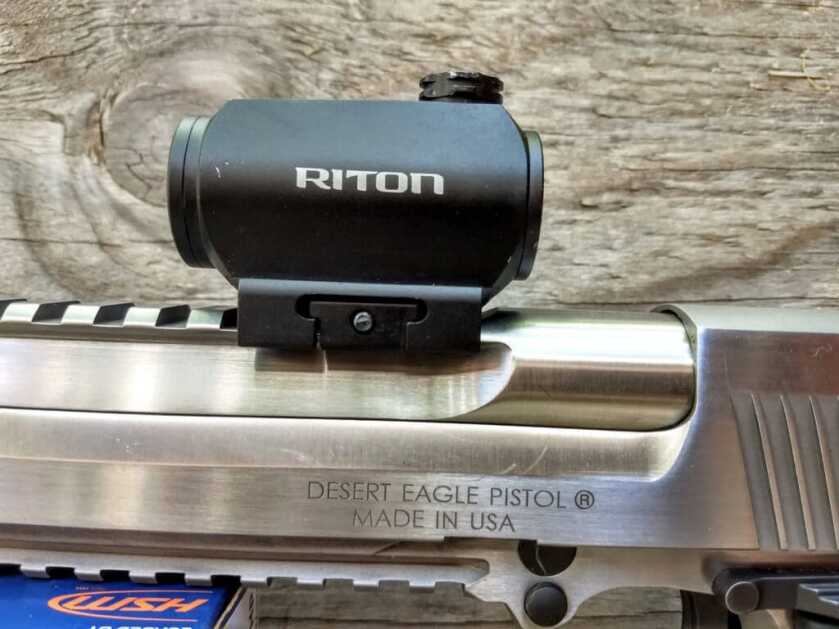
The accuracy isn’t helped by a very stiff trigger, which my Lyman Digital Trigger Pull Gauge averaged at 4.4 pounds.
I knew two other gun writers who had DE 429’s on hand for reviews and contacted them. Both had the same experiences: slides not going back into battery; and, hot brass coming back at their faces.
I chronographed the .429 DE ammunition with my PACT Professional XP Chronograph, from Brownell’s, with the unit approximately six-feet from the pistol’s muzzle. But as I only had 80 rounds total to work with, I only chronographed five rounds of each DE 429 ammunition variety.
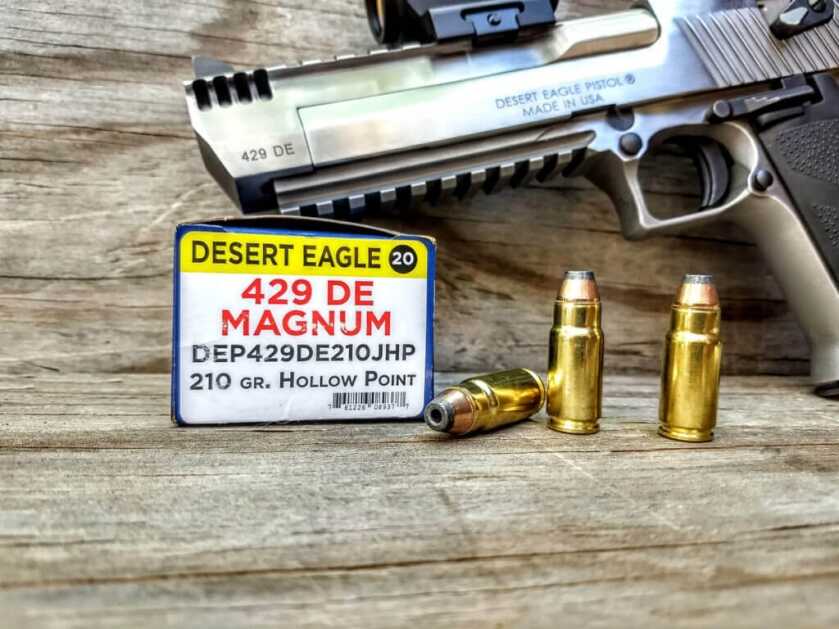
On average, the .429 DE 210-grain loads had a muzzle velocity of 1,606 feet per second (fps), with a standard deviation of 19.1 fps. The 240-grain loads averaged 1,485 fps at the muzzle, with a standard deviation of 38.2 fps.
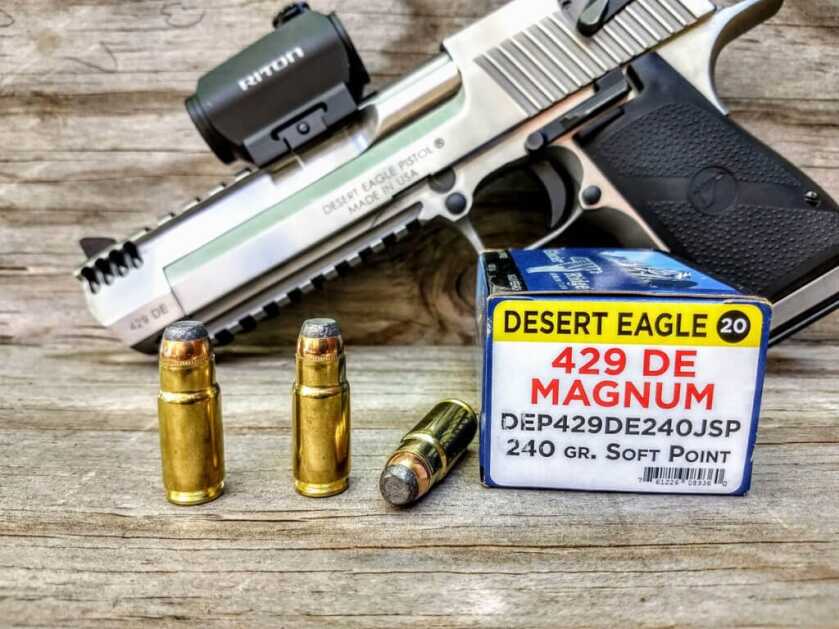
I used Hornady’s online ballistics calculator and plugged in my .429 DE ammunition specs.
The DE 429 210-grain load, leaving the muzzle at approximately 1,600 fps generates 1155-foot-pounds (ft-lbs.) of energy at 25 yards and is still at 1,022 ft-lbs. at 100 yards. With a 25 yard zero, the bullet is only dropping one inch! The 240-grain load, clocked at 1,485 fps at the muzzle has 1,128 ft-lbs. of energy at 25 yards, and a 1000 ft-lbs. at 100 yards. Drop at 100 yards, with a 25 yard zero, just 1.9 inches.
Compare that to the very popular 10MM AUTO for hunting. I’ve successfully used the Barnes VOR-TX load on several deer and hog hunts. The 155-grain Barnes bullet leaves the muzzle at 1,150 fps, is at 1,105 fps at 25 yards and 1,067 fps at 50 yards. Energy? 455 ft-lbs. at the muzzle, 421 ft-lbs. at 25 yards, and 392 ft-lbs. at 50 yards.
Certainly, the 10MM is powerful enough to take down medium-sized game. But given the energy the rounds provide, I don’t take shots beyond 40 yards.
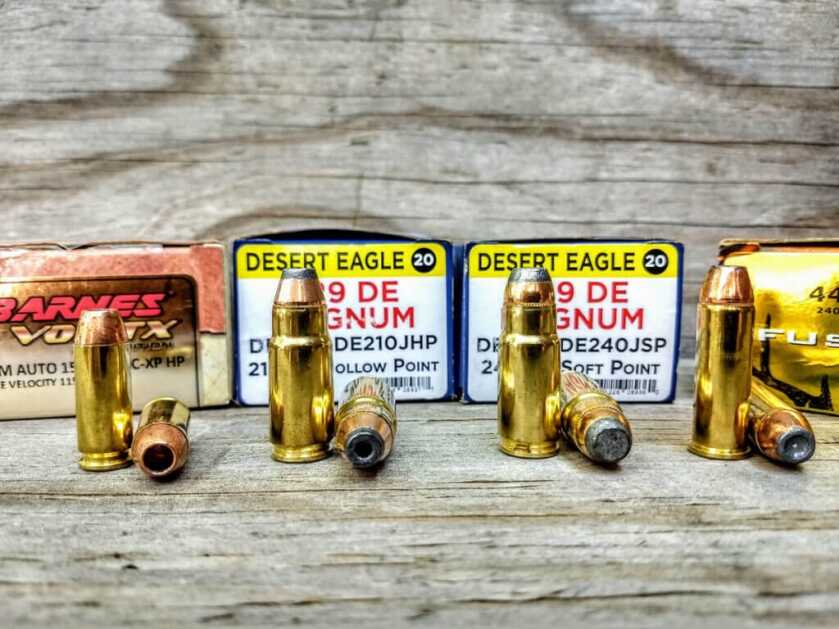
But when I look over the .429 DE ballistics? It’s clear to me that Magnum Research has created a great handgun hunting round, a true 100-yard hunter. I’d be very interested to see what the .429 DE could do in a lever action, too.
As it is, though, the next move is up to Magnum Research. If the company can re-work some key components, the Desert Eagle 429 semi-automatic could be the next hunting pistol.
SPECS: Desert Eagle 429 Mark XIX
Caliber: .429 DE
Action: Semi-Auto, gas-operated with rotating bolt
Barrel Length: 6”
Overall Length: 10.75”
Height: 6.25”
Slide Width: 1.25”
Construction: High-quality stainless steel barrel and frame, Picatinny bottom rail and slide with full Weaver-style accessory rail, and integral muzzle brake
Finish: Stainless Steel
Trigger: Single action, approx. 4.4 lbs. pull
Trigger Reach: 2.75”
Sight Radius: 8.5”
Sights: Combat type, fixed
Rifling: Polygonal, right-hand twist, 1:18
Weight (Empty Magazine): 4 lbs., 3 oz.
Magazine Capacity: 7 rounds
MSRP: $2,143.00


The old 440 Corbon guns did the same thing. Even with a Death Grip on the gun, the brass would hit the shooter in the face. It did not have issues with the slide going home though.
I think the ejection issue is attributed to the bottle neck round losing ejector tension prior to the case mouth clearing the chamber. As it extracts, the ejector shoves the case to the right, but as the case’s shoulder clears the chamber it moves outward until the neck makes contact which in turn causes the ejector to lose tension, but can’t actually eject the case at that point. Then as the case neck clears the chamber, there is no ejector tension left to toss it to the right, causing it to come straight back.
I see that you were testing the DE 429 in Stainless. Per manufacturer’s web page, this appears to be the only finish which is offered with the integral muzzle break. I have to wonder if the ejection issues and the slide not going full forward after firing a round may be due to loss of power and velocity due to the muzzle break essentially shortening the barrel?
I was considering purchasing a 429 barrel in stainless to add to my DE but with the cost of special ammunition and the issues experienced during your test, I am holding off for a while. Thank you for the thorough evaluation, DQ.
I know several of these, 429, 357, 50 AE and 44 magnum – no issues. When it i ejecting cases into your fave, you are limp writing it. No offense but that’s a fact with the Desert Eagle.
Seems like a lot of bother and expense dodging hot brass and fighting with the slide to get 1 more round and less velocity and energy than the 454 Casull delivers in the Ruger SRH for 1/3 the money. I think I’ll stick with my Glock 10mm and SRH 454 Casull, but thanks for the honest review. It’s refreshing to see someone do that. I’m really getting tired of puff piece reviews of guns in exchange for a hell of a deal on it after they are done by industry sycophants who enjoy all the free perks. And yes they do in spite of their protestations to the contrary. I have all but given up on gun rags because of it. It’s becoming a gun industry version of the MSM. Does anyone think somebody is going to honestly report about a company product that includes a free trip to Botswana to do some field testing? Like they jokingly say ” it’s tough work, but someone has to do it”…. The product recall notices published in their magazines prove they are missing some things…
“The DE 429 210-grain load, leaving the muzzle at approximately 1,600 fps generates 1155-foot-pounds (ft-lbs.) of energy at 25 yards and is still at 1,022 ft-lbs. at 100 yards. With a 25 yard zero, the bullet is only dropping one inch!”
I won’t beat around the bush. There is no way that is possible. Unless you stated the beginning conditions quoted above incorrectly those numbers don’t add up. It sounded wrong to me so I ran those numbers through a ballistic program. JBM (http://www.jbmballistics.com/) in this case.
1600 f/s muzzle velocity
25 yard zero
Ballistic coefficient of 0.16. Sierra has a 0.429″ 210 gr. soft point with that B.C. But with handguns, and handgun distances, it doesn’t make much difference. Try it yourself by varying the B.C. while leaving everything else constant.
Sight height 0.7″ a guess on my part but reasonable.
Standard weather conditions
The results:
0 yards -0.7″ drop 1600.0 f/s 1193.5 ft*lbs
25 yards -0.0″ drop 1499.7 f/s 1048.6 ft*lbs
100 yards -4.2″ drop 1243.2 f/s 720.6 ft*lbs
Those numbers are impressive for a handgun but nothing like the numbers above. Whoever told you (the author) the numbers I quoted from you above should not be trusted.
I sold many DE’s back in the day, this is a recurring problem in several calibers. Once broken in, most settle down and are reliable.
However, I did find several with galling of the slide and frame, so this is an area to check.
I bought a lone XIX DE with a 44 and 50 barrel and mags back when IMI made them. Its what got me into reloading. When shooting the gun make sure you don’t put pressure on the magazine as it is supposed to float (especially on a rest). Also you have to really maintain rigidity in your wrist or the gun will tilt up and right under recoil and kick casings into your face. The action has to fully cycle back to get the energy and real estate going forward to push the next round into battery. The gun might need a 100 or so to break in, I think mine did. I can shoot both the 50 with 350 grain plated bullets and 44 with 180 grain jacketed bullets loaded with H110 in the same frame and it cycles dry or dirty or both. Its an interesting gun and a lot of fun to shoot, I hope you give it another try.
I agree that an extremely firm, two-handed “push-pull” grip is the key to reliable performance. It’s when I forget and revert to my normally relatively relaxed grip that I get reminded with a thwack of 44 or 50 case to the goggles, and/or cycling malfunctions.
I didn’t know that about letting the magazine float, but it makes sense, thank you.